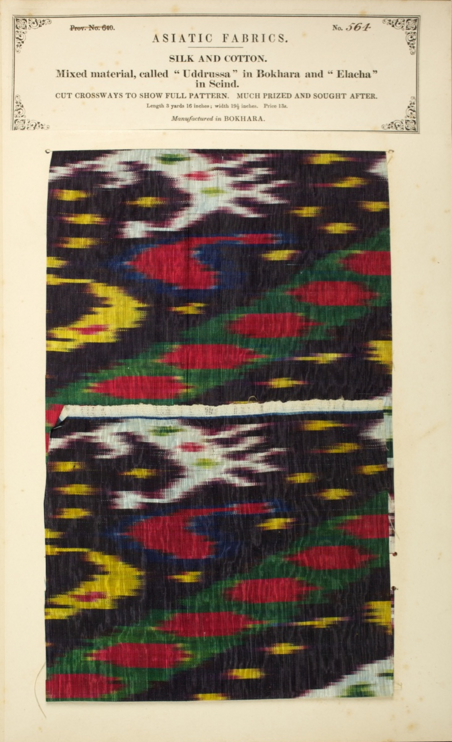INDUSTRIAL INSPIRATION
Photography in galleries is a much debated subject – there’s the condition of the exhibits to consider, the gallery atmosphere and what’s more the essential purpose of a gallery becomes open to interpretation. When you’re not a visitor interested in having a selfie taken with the Mona Lisa, it may seem obvious that all photography in galleries should be prohibited. But what if you’re interested in something small, niche or entirely relevant to your work but not printed on a postcard? It can be frustratingly difficult to take any useful reference away with you. Hence, online archives are a god-send for many. Not only do you have an entire collection at your finger tips but it also provides the opportunity to see work that otherwise might lurk, unseen, in an archive.
 The Harris Museum and Art Gallery’s archive of seven hundred South Asian textile samples, The Textile Manufacturers of India, has been made accessible for all online. As anyone who has ever tried to systematically archive anything will realise, this is a huge feat in terms of curatorial and technical work. Appropriately the collection itself is also the fruits of an ambitious attempt to collate information.
The Harris Museum and Art Gallery’s archive of seven hundred South Asian textile samples, The Textile Manufacturers of India, has been made accessible for all online. As anyone who has ever tried to systematically archive anything will realise, this is a huge feat in terms of curatorial and technical work. Appropriately the collection itself is also the fruits of an ambitious attempt to collate information.
 The Textile Manufacturers of India was originally put together by John Forbes Watson (1827-1892), who, following a career as a physician in the Bombay Medical Service, worked at the India Museum. Keen for this museum’s collection to be of benefit to British industry, Forbes Watson and his team of assistants cut up historic fabrics from the museum’s stores to produce twenty sets of seven hundred samples in eighteen volumes.
The Textile Manufacturers of India was originally put together by John Forbes Watson (1827-1892), who, following a career as a physician in the Bombay Medical Service, worked at the India Museum. Keen for this museum’s collection to be of benefit to British industry, Forbes Watson and his team of assistants cut up historic fabrics from the museum’s stores to produce twenty sets of seven hundred samples in eighteen volumes.

 The Harris Museum and Art Gallery’s archive of seven hundred South Asian textile samples, The Textile Manufacturers of India, has been made accessible for all online. As anyone who has ever tried to systematically archive anything will realise, this is a huge feat in terms of curatorial and technical work. Appropriately the collection itself is also the fruits of an ambitious attempt to collate information.
The Harris Museum and Art Gallery’s archive of seven hundred South Asian textile samples, The Textile Manufacturers of India, has been made accessible for all online. As anyone who has ever tried to systematically archive anything will realise, this is a huge feat in terms of curatorial and technical work. Appropriately the collection itself is also the fruits of an ambitious attempt to collate information.
 The Textile Manufacturers of India was originally put together by John Forbes Watson (1827-1892), who, following a career as a physician in the Bombay Medical Service, worked at the India Museum. Keen for this museum’s collection to be of benefit to British industry, Forbes Watson and his team of assistants cut up historic fabrics from the museum’s stores to produce twenty sets of seven hundred samples in eighteen volumes.
The Textile Manufacturers of India was originally put together by John Forbes Watson (1827-1892), who, following a career as a physician in the Bombay Medical Service, worked at the India Museum. Keen for this museum’s collection to be of benefit to British industry, Forbes Watson and his team of assistants cut up historic fabrics from the museum’s stores to produce twenty sets of seven hundred samples in eighteen volumes.

Of the twenty sets, thirteen were given to textile manufacturing towns in Britain and the rest were given to trade centres in South Asia. Each page gave information on the size of the textile as woven, the price and where it was produced so the collection was of real practical use to British manufacturers.

 Forbes Watson was in many ways the archetypal Victorian man: born in Edinburgh his specialisms spanned Empire, science, botany and industry. And yet in many ways his work and mind would have been perfectly suited to the internet age. Not only does his initiative to comprehensively archive so many samples reflect an organised mind that would no doubt relish an excel spreadsheet: but the, albeit industry-driven, idea to share resources chimes with an egalitarian view of the internet.
The Textile Manufacturers of India aimed to show British industry the sorts of fabrics used in South Asia so that they might sell to this huge potential market. (The ethics of trying to flood this market with cheap, mass-produced British copies is perhaps a debate for another occasion.) Now the Harris Museum and Art Gallery’s online resource aims to broaden, explore and inspire the contemporary conversation surrounding the collection.
www.tmoi.org.uk
This is an extract from Grace Warde-Aldam's article in the Green issue of Selvedge.
Forbes Watson was in many ways the archetypal Victorian man: born in Edinburgh his specialisms spanned Empire, science, botany and industry. And yet in many ways his work and mind would have been perfectly suited to the internet age. Not only does his initiative to comprehensively archive so many samples reflect an organised mind that would no doubt relish an excel spreadsheet: but the, albeit industry-driven, idea to share resources chimes with an egalitarian view of the internet.
The Textile Manufacturers of India aimed to show British industry the sorts of fabrics used in South Asia so that they might sell to this huge potential market. (The ethics of trying to flood this market with cheap, mass-produced British copies is perhaps a debate for another occasion.) Now the Harris Museum and Art Gallery’s online resource aims to broaden, explore and inspire the contemporary conversation surrounding the collection.
www.tmoi.org.uk
This is an extract from Grace Warde-Aldam's article in the Green issue of Selvedge.

 Forbes Watson was in many ways the archetypal Victorian man: born in Edinburgh his specialisms spanned Empire, science, botany and industry. And yet in many ways his work and mind would have been perfectly suited to the internet age. Not only does his initiative to comprehensively archive so many samples reflect an organised mind that would no doubt relish an excel spreadsheet: but the, albeit industry-driven, idea to share resources chimes with an egalitarian view of the internet.
The Textile Manufacturers of India aimed to show British industry the sorts of fabrics used in South Asia so that they might sell to this huge potential market. (The ethics of trying to flood this market with cheap, mass-produced British copies is perhaps a debate for another occasion.) Now the Harris Museum and Art Gallery’s online resource aims to broaden, explore and inspire the contemporary conversation surrounding the collection.
www.tmoi.org.uk
This is an extract from Grace Warde-Aldam's article in the Green issue of Selvedge.
Forbes Watson was in many ways the archetypal Victorian man: born in Edinburgh his specialisms spanned Empire, science, botany and industry. And yet in many ways his work and mind would have been perfectly suited to the internet age. Not only does his initiative to comprehensively archive so many samples reflect an organised mind that would no doubt relish an excel spreadsheet: but the, albeit industry-driven, idea to share resources chimes with an egalitarian view of the internet.
The Textile Manufacturers of India aimed to show British industry the sorts of fabrics used in South Asia so that they might sell to this huge potential market. (The ethics of trying to flood this market with cheap, mass-produced British copies is perhaps a debate for another occasion.) Now the Harris Museum and Art Gallery’s online resource aims to broaden, explore and inspire the contemporary conversation surrounding the collection.
www.tmoi.org.uk
This is an extract from Grace Warde-Aldam's article in the Green issue of Selvedge.

1 comment
This is fascinating and what a fantastic historical artifact and resource. However, I think the ethics of this systematic appropriation and calculated undermining of an entire indigenous industry is actually quite relevant, given the modern practice continues (viz. “tribal” patterns, Isabel Marant’s legal cases, et al). Carry Somers of Pachacuti and FashionRevolution.org just posted on Instagram photos of local Mexican weavers’ embroidered statements about misappropriation of their work. I’m disappointed you skirted the topic, especially for an issue on “green” textiles— social ethics are equally relevant to sustainability, when it comes to the environmental impact of global industrial fabric production and its resource usage, toxicity, waste management, etc. vs. local production.